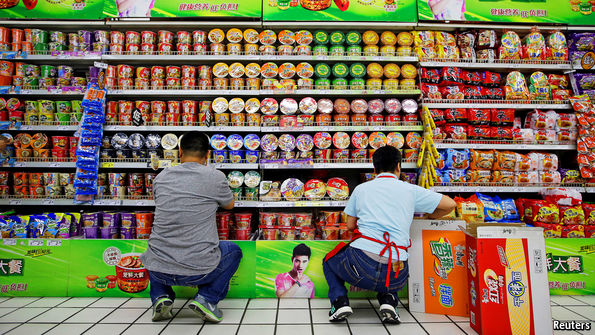Franchising, retail, business

29/06/2016
The tastes of China’s consumers are rapidly changing
SOARING sales of instant noodles have for years been a reliable indicator of the insatiable appetites of China’s rising consumer class. China is the world’s biggest market for these flash-fried snacks infused with monosodium glutamate (MSG), a chemical that makes flavourless food more palatable. Locals slurp down over 40 billion packets each year. Now comes news of a nasty noodle meltdown.
It is less a sign that China’s long consumer boom is waning than that Chinese tastes are changing.
The volume of instant noodles gobbled last year fell by 12.5%, according to a new report on China’s consumer market from Bain, a consultancy, and Kantar Worldpanel, a market-research firm. The consequences for firms such as Tingyi, whose Master Kong noodles are found everywhere from railway canteens to kitchen cupboards, have been severe. Profits for China’s biggest instant-noodle firm fell by 36% in 2015, to $256m, as hungry Chinese consumers turned their backs on its wares. Even more shocking, the volume of beer sold in China—the world’s biggest guzzler—fell by 3.6% last year, largely because of plunging sales of cheap brands.
Brands that cater to blue-collar workers, like instant noodles and bottom-of-the-barrel brews, are being squeezed as a painful downturn in the industrial economy hurts workers in those sectors. This slowdown is affecting sales of many basic consumer goods, ranging from toothpaste to packaged foods.
But these days non-industrial activities account for more than half of China’s economy. These businesses are faring rather better than the factories of China’s rust belt. Most company bosses remain confident about China’s future. A survey of over 1,200 chief executives worldwide recently published by KPMG, a consulting firm, finds that bosses still consider China the most promising growth market, along with India. Of the 129 bosses surveyed that are running firms in China, half said investing in innovation and launching new products will be the main priority to ensure growth over the next three years—hardly signs of a sinking consumer market.
The middle classes in the country’s bigger cities, confident urban professionals with jobs in service industries, are indeed still splashing out. This explains a trend towards premium goods from fancier brands. Sales of make-up grew by over 15% last year, for example, and skincare products by 13%, driven by demand for pricier cosmetics to pamper and primp China’s better-off consumers.
Many such consumers are upgrading, experimenting and exploring. A report released on June 30th by Oliver Wyman, a consultancy, predicts that Chinese will make over 130m trips abroad this year, up from some 120m in 2015, and spend roughly $1,200 each time on shopping. Seduced by the country’s soap operas and K-Pop teen bands, many will visit South Korea. Chinese tourists return home with a taste for cosmetics brands based there, such as Laneige and Innisfree, which are now more popular than European competitors. South Korean cosmetics exports to China surged by 250% last year.
Brands that promise healthy lifestyles are also thriving. In a recent survey, the top complaint by Chinese consumers was poor food safety and the next biggest grouse was shoddy health care. These attitudes have helped restaurants and supermarkets with names like “Element Fresh” and “Pure and Whole” spread like organic mushrooms across the land. Yoga and running are all the rage (in March thousands of entrants suffered injuries trying to finish a marathon in Qingyuan, a southern city), and fitness firms are booming. Adidas, a German sportswear company, saw sales rise by 18% in China last year.
The sort of indulgences common among young Western urbanites are also now growing fast in China. “Functional drinks”, favoured by the health-conscious, are going down well. Sales of yogurt rose by over a fifth last year, a striking development in a country full of people who are lactose-intolerant. Tingyi recently introduced Master Soup with no MSG to cater to healthier slurpers.
A new China is emerging, then. But companies that wish to serve it must remember that the old one has not gone away. Sales of pet food rose by nearly 12% in 2015, a reflection of a softening of Chinese attitudes toward animals. Yet in the southern city of Yulin crowds still flocked recently to an annual festival of lychees and dog meat.
Fonte:http://www.economist.com/news/business/21701534-tastes-chinas-consumers-are-rapidly-changing-noodles-poodles?fsrc=scn/tw/te/pe/ed/fromnoodlestopoodles